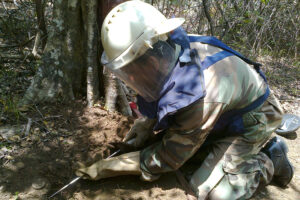1. Land Release and EORE
The release of safe land and implementation of Inclusive EORE activities result in completion and facilitate sustainable development
 The National Mine Action Completion Strategy presents the strategic orientation for Sri Lanka’s mine action program from 2023 to 2027, developed by the National Mine Action Centre (NMAC) with the support of the Geneva International Centre for Humanitarian Demining (GICHD). It builds on accomplishments and draws on good practice and lessons learnt from Sri Lanka’s previous National Mine Action Strategy.
The National Mine Action Completion Strategy presents the strategic orientation for Sri Lanka’s mine action program from 2023 to 2027, developed by the National Mine Action Centre (NMAC) with the support of the Geneva International Centre for Humanitarian Demining (GICHD). It builds on accomplishments and draws on good practice and lessons learnt from Sri Lanka’s previous National Mine Action Strategy.
It reinforces Sri Lanka’s commitment to implementing its international convention obligations under the Anti-Personnel Mine Ban Convention (APMBC), the Convention on Cluster Munitions (CCM), the Convention on the Rights of Persons with Disabilities (CRPD) and the Convention on Certain Conventional Weapons (CCW), in line with the Sustainable Development Goals (SDGs).
1. Land Release and EORE
The release of safe land and implementation of Inclusive EORE activities result in completion and facilitate sustainable development
2. Coordination and National Ownership
Strengthened coordination and national ownership result in raised awareness, greater transparency and increased collaboration
3. Management of residual contamination
Residual EO contamination is effectively managed with sustainable national structures, ensuring safer communities
4. Staff transition
Sri Lanka's staff transition process facilitates access to alternative economic activities and promotes safe and sustainable livelihood activities

Keeping international donors informed of challenges and operational stand-downs, ensuring transparency and continuous communication

National Mine Action Strategy-clarity on strategic priorities
Resource mobilisation strategy that presents clear targets

Lobby the treasury to ensure NMAC, RMAO and SLA HDU are fully resourced to carry out their responsibilities
National Mine Action Strategy-clarity on strategic priorities

Sri Lanka's new national mine action strategy
Commitment to strengthened communication and coordination

Adapt and capitalize on lessons learnt and good practice from the last two years
Sectoral pandemic guidelines

Monitoring the labour market and economic prospects on a regular basis;
Adapting staff transition interventions to environment and context;
Keeping international donors informed challenges and external constraints
The NMAC and the SLA HDU are working closely with national operators Delvon Assistance for Social Harmony (DASH) and Skavita Humanitarian Assistance and Relief Project (SHARP), and international operators HALO Trust and Mines Advisory Group (MAG) to identify and clear EO and deliver EORE in line with IMAS, drawing on funding from the GoSL and several international donors. With Sri Lanka’s 2017 accession to the APMBC and in line with its Article 5 obligations, it has committed to identifying and clearing all AP mined areas by 1 June 2028.
Sri Lanka will continue to demonstrate strong national ownership of its mine action programme, including by ensuring its national mine action structures are sufficiently equipped and resourced to effectively execute their mandate.
NMAC commits to ensuring regular and structured coordination and transparent information sharing with Sri Lanka government representatives, international donors, operators and other partners, and will, in close collaboration with partners, organise bi-annual coordination meetings.
As a State Party to the APMBC, CCM and CRPD, Sri Lanka’s mine action programme commits to addressing strategic victim assistance (VA) challenges related to information management, coordination and awareness raising.
Resource mobilisation will be an ongoing effort, targeting the GoSL and international partners. Sri Lanka’s mine action programme will seek to increase national funding from the GoSL, expand its international donor base and explore other sources of funding.
Sri Lanka expects to transition from pro-active survey and clearance of known EO contamination to reactively responding to reported residual contamination by the end of 2027. Through a staged process, the GoSL will ensure that the SLA HDU is appropriately equipped, staffed and sufficiently resourced to fulfil its responsibilities. As part of this transition process to a residual context, it will also be important to ensure that mine action information (including data on previously surveyed and cleared areas, EO accident locations, etc.) is easily accessible and that any future residual EO contamination data can be collected and stored. Sri Lanka’s Police Task Force will play a role in explosive ordnance disposal (EOD) call outs.
Sri Lanka will also ensure that sustainable EORE structures will continue to be strengthened to promote safe behaviour and reduce the risks of future EO accidents
Sri Lanka’s mine action programme employed more than 3’000 female and male demining staff. As completion is expected by the end of 2027, the importance of ensuring that an appropriate and sustainable staff transition process is in place is becoming increasingly important.
Against this backdrop, MAG took the initiative to develop a Skills Acquisition and Post-demining Livelihood Transition Strategy in 2020-2021, to support MAG’s demining staff to transition to alternative economic activities when made redundant, and to support the incorporation of mine action staff transition into Sri Lanka’s new national mine action strategy. Representatives from DASH, SHARP, HALO and GICHD were members of the Advisory Committee, while NMAC was heavily involved in the process of developing the transition strategy.
This strategic objective draws heavily on the staff transition strategy developed by MAG, and the staged process it presents. The staff transition process is structured around three main phases:
The GoSL, with NMAC in the lead, will promote deminers’ smooth transition to alternative, sustainable economic activities.